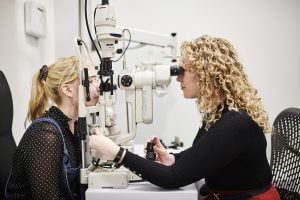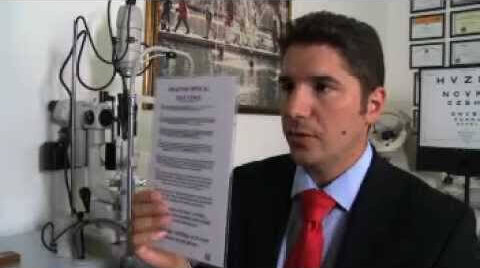What is Glaucoma?

Glaucoma is a group of eye diseases that cause damage to the optic nerve – the nerve that carries messages from the retina to the brain. Over time, this can lead to irreversible vision loss and even blindness if left untreated.
Glaucoma is the second-leading cause of blindness in the UK, behind cataracts. It is estimated that around 2% of people over 40 in the UK are affected by primary open-angle glaucoma (POAG), the most common type of the disease, with prevalence increasing with age. As a whole, ocular hypertension affects 3-5% of people over 40 in the UK.
While glaucoma is more common in older people, it can affect people of all ages. In the video below, Dr Glenn Carp tells us more about glaucoma.

What Causes Glaucoma?
The exact cause of glaucoma is unknown but it is usually associated with a build-up of fluids inside the eye which leads to increased internal eye pressure (intraocular pressure or IOP). This elevated pressure can damage the optic nerve which can cause changes such as pathological cupping or pallor of the optic disc and vision loss.
While other eye conditions can be extremely recognisable, symptoms of glaucoma can develop so slowly that patients often don’t notice them at first. In fact, it is thought that around half the people in the UK with POAG have not been diagnosed and so are unaware that they have it. However, as the disease progresses, loss of peripheral (side) vision and blind spots may become apparent.
Due to its lack of symptoms in the early stages of the disease, glaucoma is often called “the silent thief of sight”. If left untreated, it can cause permanent vision loss and blindness. The only way to diagnose glaucoma is through a comprehensive dilated eye exam.
The Different Types of Glaucoma
There are four main types of glaucoma, though some are much rarer than others:
- Primary Open-Angle Glaucoma (POAG) – the most common type of glaucoma. It occurs when fluid in the eye is not able to drain as well as it should. There are often no symptoms in the early stages of the condition though patients eventually notice a loss of peripheral vision.
- Primary Angle-Closure Glaucoma (PACG) – occurs when intraocular fluid cannot drain due to a variation in the angle of the eye’s anterior chamber. PACG can cause symptoms such as pain and redness in the eye; however, like POAG, symptoms often go unnoticed at first.
- Congenital Glaucoma – also known as childhood or infantile glaucoma, is a form of the disease that develops in babies and young children. It is often inherited and usually diagnosed within the first year of life.
- Secondary Glaucoma – called ‘secondary’ as it can occur due to a number of other primary conditions or factors, such as surgery, trauma or physical injury, inflammation, certain medications, and syndromes such as pseudo-exfoliation and pigment dispersion.
What is the treatment for Glaucoma?
There is no cure for glaucoma and damage already inflicted cannot be reversed. However, a number of treatments can help to slow the progression of the disease and prevent further vision loss.
For this reason, early diagnosis of the disease is incredibly important. The primary aim of glaucoma treatments is usually to reduce intraocular pressure and so limit further damage to the optic nerve.
Treatment options for glaucoma include:
- Eye Drops – These products work either by facilitating fluid drainage or reducing the amount of fluid secreted inside the eye for open-angle glaucoma. In the treatment of closed-angle glaucoma, medicine is given rapidly into circulation through a vein to reduce pressure quite quickly.
- Laser Treatment – Lasers can also be used to reduce pressure in the eye as a treatment for glaucoma. Again, this treatment is used to temporarily improve drainage in the eye in POAG. In the treatment of PACG, lasers are used to create a hole in the iris which can help to prevent the condition from happening again.
- Surgery – Surgical procedures can be performed to create a new drainage channel for fluid to leave the eye. This can be a very effective procedure but it may result in a small blister on the eye, hidden under the upper eyelid and medicine used to reduce the risk of scarring.
Glaucoma is a complex eye condition but it is often possible to manage it effectively. Furthermore, a diagnosis of glaucoma may not necessarily make you unsuitable for treatments such as Laser Eye Surgery and Cataract Surgery.
If you have glaucoma and would like to learn more about your options, get in touch with one of our friendly clinic coordinators or Book a Consultation today.


